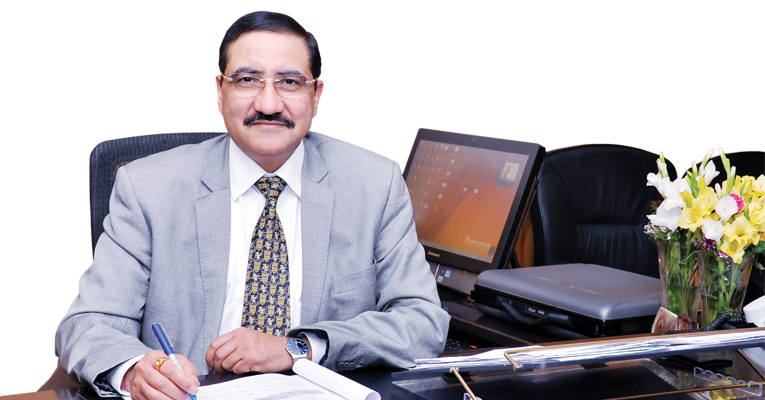DFC game changer in freight transport

To decongest already saturated road network and promote shifting of freight transport to more efficient rail transport, Dedicated Freight Corridor Corporation of India (DFCCIL), a special purpose vehicle has been set up by the Ministry of Railways, to undertake planning and development, mobilisation of financial resources and construction, maintenance and operation of Dedicated Freight Corridors (DFC).
With a vast experience in civil engineering and construction in rail transportation, and many awards and accolades to his credit, Adesh Sharma heads the Dedicated Freight Corridor project. In conversation with Rashmi Pradhan, the MD of DFCCIL talks about feasibility and status of the project
How will introduction of DFC boost Indian Railways? A mega infrastructure project, DFC will be a game changer in the freight transport sector of the country. The plan to construct dedicated freight corridors across the country marks a strategic inflexion point in the history of Indian Railways that has essentially run mixed traffic across its network. Once completed, the dedicated freight corridors will enable Indian Railways to improve its customer orientation and meet market needs more effectively. Creation of rail infrastructure on such a scale — unprecedented in independent India — is also expected to drive the establishment of industrial corridors and logistic parks along its alignment.
The golden quadrilateral and its diagonals constitute 16 per cent of route length of Indian railway network but carry 60 per cent of the total freight traffic. The Eastern & Western Dedicated Freight Corridors constitute 22 per cent of total Indian railway traffic and these routes are fully saturated. Line capacity utilisation has reached more than 125 per cent and due to serious capacity constraint, average speed of goods train has dropped to 25 kmph.
The average speed of trains on DFC route will be 70 kmph leading to guaranteed transit times and time tabled running of freight trains. The average speed of freight train on DFC will increase by three-fold. The length of trains will be increased from 700 metre to 1500 metre and carrying capacity will increase from 5000 tonnes to 13000 tonnes/train. The structures on Western Corridors are designed to carry double stack containers. The unit cost of transport is also expected to reduce by 40 per cent. DFC routes are constructed with the double line and it is also provided with automatic signalling thereby more than 150 trains can run in each direction.
Initially, it is planned to divert 70 per cent of the freight traffic running on the parallel routes of Indian Railways and during the course of time, the road traffic will also get diverted to rail as DFCC will provide very efficient, economical, safe and faster mode of transport. This will help in improvement of railway share from 36 per cent to 45 per cent.
Please elaborate on the status of projects in Eastern and Western Corridor? The Eastern Dedicated Freight Corridor (EDFC) with a route length of 1856 km consists of two distinct segments - 1318 km between Ludhiana to Sonnagar is under execution and balance section between Sonnagar to Dankuni (538 km) will be taken up under PPP. Civil contracts for 83 per cent length have already been awarded and work is in progress on Khurja-Kanpur (343 km), Kanpur-Mughalsarai (402 km), Mughalsarai –Sonnagar Section (126 km), Pilkhani-Sahnewal (179 km) & Khurja-Dadri (46 km).
The Western Dedicated Freight Corridor (WDFC) covers a distance of 1504 kilometre of double line electric track from JNPT to Dadri via Vadodara-Ahmedabad-Palanpur-Phulera-Rewari. All civil contracts for Western DFC have already been awarded and work is in progress on Rewari-Iqbalgarh (639 km), Iqbalgarh-Vadodara (308 km), Vadodara –Vaitarna (322 km), Vaitarna-JNPT (110 km) and Rewari-Dadri section (127 km). All electrical, signalling and telecommunication contract have also been awarded and design work is in progress.
It is proposed to develop logistics parks on public private partnership at Ateli in Haryana, Sanand in Gujarat and Kanpur in UP. Delhi Mumbai Industrial Corridor Development Corporation (DMICDC) is coming up along WDFC which would set up industrial hubs and lead to growth of Industries along the WDFC. DFCCIL is encouraging development of Private Freight Terminals along the corridors.
What is the traffic forecast in this route? The total traffic on the Eastern DFC is expected to grow from 141,207 million Net Tonne Kilometre (NTKM) in 2016-17 to 289,708 million NTKM in 2036-37 while on the Western DFC it is expected to grow from 113,373 million NTKM in 2016-17 to 302,544 million NTKM in 2036-37. In million tonnes, the expected traffic is as follows:
Tell us about the project funding. The cost estimate of Rs 81,500 crore for two corridors including land cost has been approved by the Cabinet Committee on Economic Affairs in June 2015. This comprise construction cost of Rs 73,392 crore (including Soft Cost of Rs 19,390 crore) and land cost of Rs 8,067 crore. The cost for the project will be funded by a combination of debt from bilateral/multilateral agencies and equity from Ministry of Railways. The section between Son Nagar to Dankuni is planned to be taken up on PPP. The capital structure of DFCCIL will entail a debt equity ratio of 3:1. The Eastern DFC is funded by World Bank whereas Western DFC will be funded by JICA.Both corridors are expected to be completed by December 2019.




